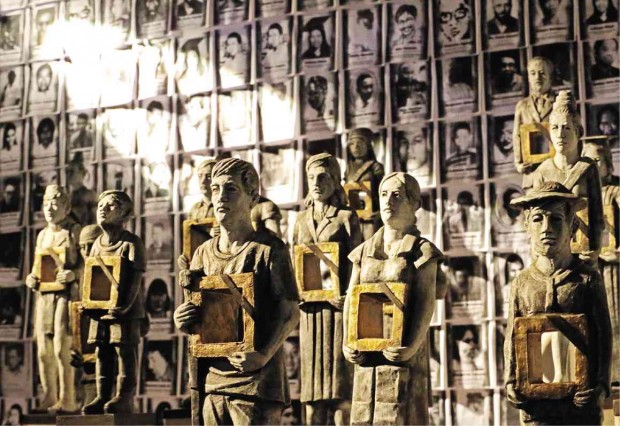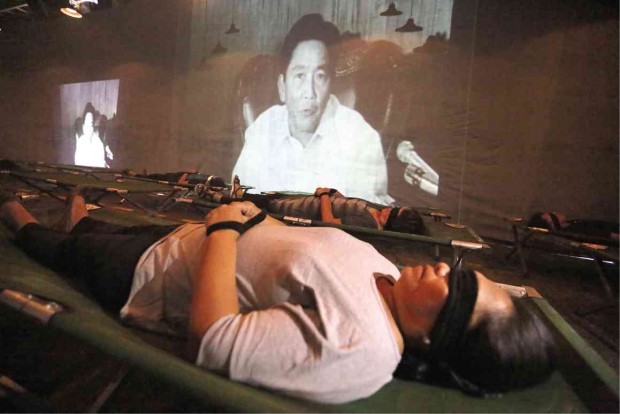Edsa museum shocks, awes millennials

STATUES representing those who disappeared during martial law along with photos of victims of torture or extrajudicial killings reside in the museum’s “The Hall of the Lost” (above).
“I VALUE my freedom more now, knowing how hard the situation was before.”
This was the realization Angel Almoguerra, 15, came to after her visit to the People Power Experiential Museum at Camp Aguinaldo in Quezon City on Friday.
Interviewed by the Inquirer after she and her classmates from the Pasay City East High School finished the 40-minute tour, Almoguerra admitted she was “a little shocked” by what she saw.
The museum, through performance and visual arts, depicted the atrocities committed by the late dictator, former President Ferdinand Marcos, after he imposed martial law. Its two-day run was part of the activities commemorating the 30th anniversary of the 1986 Edsa People Power revolution which resulted in his ouster.
Almoguerra said while her elders and teachers had told her that there were many victims of extrajudicial killings and torture during martial law, “I never knew who they were. Now I do.”
Article continues after this advertisementShe expressed awe in particular at the museum’s “The Hall of Forgotten Martyrs,” which featured performance artists reenacting the cold-blooded killings of martial law activists and Marcos critics such as Ateneo student leader Edgar Jopson, tribal leader Macli-ing Dulag, freedom fighter Maria Lorena Barros and politician Evelio Javier.
Article continues after this advertisement“Ninoy Aquino was the only one I knew,” she said, referring to the father of President Aquino whose assassination served as the trigger for the bloodless people’s revolution on Edsa.
For Almoguerra, the museum “showed what really happened: That people disappeared or were killed because they fought against the Marcos administration, and that was what pushed the Filipinos to fight for freedom during the People Power Revolution.”
For the Edsa People Power Commission (EPPC) which put up the museum, it opted to focus more on the martial law years than the 1986 uprising.

In “The Hall of Restless Sleep,” TV screens show the dictator announcing the declaration of martial law as people lie in slumber. Photos by RAFFY LERMA
“We feel that for the past 30 years, the celebration [has been focused] on the last four days [of the Marcos administration]. We never really talk about what caused those four days,” explained EPPC spokesperson Assistant Secretary Celso Santiago.
Santiago admitted that as a youngster, he was also largely unaware of the atrocities during martial law. Only 5 years old when Marcos and his family were forced into exile, he recalled that his school books dedicated just one page to the events during martial law.
“I was lucky my parents told me about it, and they were at Edsa. But not everyone is as lucky as I am. I have friends who have no idea what happened. And I have younger friends who don’t care,” he said.
Santiago dismissed criticisms by netizens that the museum was being used to favor or discredit some candidates for the May elections.
“It is not for or against any candidate. It is a campaign for truth. What the commission wants to tell young people is the whole story. There are no judgments, just facts. Whatever effect it has on the elections, that’s not our objective,” he said.
For Sherwin Dumago, 16, the visi t to the museum helped him make up his mind.
“My parents told me about [Filipinos uniting] to fight against martial law and usher in democracy for the Philippines; that martial law was [a] cruel [time], and that many people died,” he said. “But I also have an aunt who said the opposite: That the period was a prosperous time for the Philippines,” Dumago told the Inquirer.
“I [now] believe my parents. There is so much proof here [in the museum] that many people suffered,” he said.
“Some of us don’t really know [about all this] but that’s because they don’t give importance to the details of the past. Now I can tell my peers: Do more research. I hope they can experience this [museum] like we did. We [learned more] about what Edsa meant,” Dumago added.
Santiago observed that the Edsa People Power Experiential Museum provided lessons not just for millennials but for martial law survivors as well.
“When they came out, they said, ‘Thank you very much for telling our story.’ Some of them were thankful for the reminder [that they should tell] more young people about [their experience],” he said.
“I think one of Edsa’s unfinished business is that those who went through it sort of did not give too much attention on ensuring that young people [knew] about it. I guess we all got caught up in the task of rebuilding the nation because of the mess we inherited,” Santiago observed.
“Now we hope this museum becomes a movement, so that more and more people can really tell the story. Government cannot do it alone. We’re counting on those who went through it. It’s everyone’s responsibility to tell young people of mistakes we did so we don’t repeat them,” he said.
The EPPC plans to set up a permanent “1986 Memory Museum” at the People Power Monument showcasing both the experiential museum and the archival data and testimonial interviews it had collected. It also hopes to set up a smaller version of the experiential museum in Quezon City.